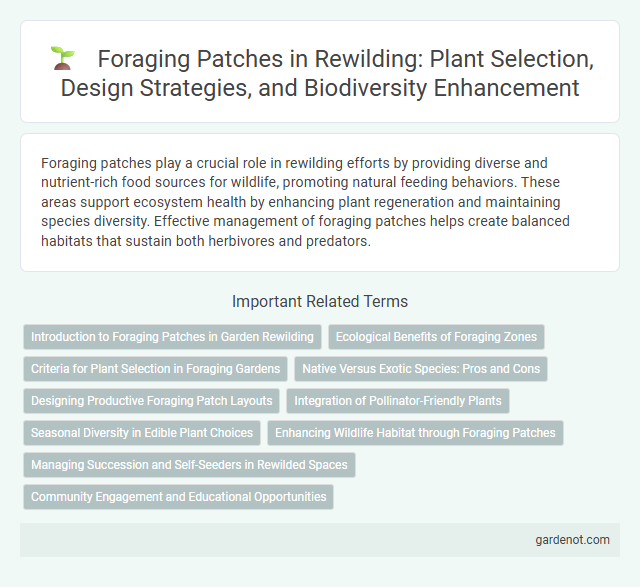Foraging patches play a crucial role in rewilding efforts by providing diverse and nutrient-rich food sources for wildlife, promoting natural feeding behaviors. These areas support ecosystem health by enhancing plant regeneration and maintaining species diversity. Effective management of foraging patches helps create balanced habitats that sustain both herbivores and predators.
Introduction to Foraging Patches in Garden Rewilding
Foraging patches in garden rewilding create biodiverse habitats by allowing native plants to flourish naturally, supporting local wildlife and pollinators. These patches provide essential food sources such as berries, nuts, and edible leaves, promoting ecological balance and sustainable food harvesting. Incorporating diverse foraging species enhances soil health and encourages symbiotic relationships within the garden ecosystem.
Ecological Benefits of Foraging Zones
Foraging patches enhance biodiversity by providing diverse plant species that support pollinators and wildlife, promoting ecological balance. These zones improve soil health through natural nutrient cycling and reduce erosion by maintaining vegetative cover. Creating foraging areas contributes to habitat connectivity, facilitating species movement and resilience in rewilding landscapes.
Criteria for Plant Selection in Foraging Gardens
Criteria for plant selection in foraging gardens include native species that support local biodiversity and provide high nutritional value for both humans and wildlife. Plants should have resilience to local climate conditions, minimal maintenance requirements, and a proven capacity to attract pollinators. Prioritizing perennial plants with multiple uses enhances sustainability and ecosystem restoration in rewilding projects.
Native Versus Exotic Species: Pros and Cons
Foraging patches featuring native species support local ecosystems by providing habitat and food sources for indigenous wildlife, promoting biodiversity and ecological balance. Exotic species may offer novel food resources and extend foraging seasons but risk outcompeting native flora, disrupting soil health, and introducing pests or diseases. Carefully selecting native over exotic plants in rewilding foraging patches optimizes ecosystem resilience and supports long-term ecological restoration goals.
Designing Productive Foraging Patch Layouts
Designing productive foraging patch layouts involves strategically arranging diverse native plant species that provide year-round food sources for wildlife and support ecological balance. Incorporating layered vegetation structures optimizes habitat complexity, enhancing foraging efficiency and biodiversity. Effective patch design maximizes nutrient cycling and habitat connectivity, contributing to long-term ecosystem resilience in rewilding projects.
Integration of Pollinator-Friendly Plants
Foraging patches designed with pollinator-friendly plants enhance biodiversity by attracting bees, butterflies, and other essential pollinators that support ecosystem stability. Incorporating native flowering species such as clover, lavender, and wild thyme creates continuous blooms that provide vital nectar and pollen throughout the growing season. This strategic integration boosts plant reproduction, enriches soil quality, and fosters a resilient, self-sustaining habitat within rewilding projects.
Seasonal Diversity in Edible Plant Choices
Foraging patches offer a crucial source of seasonal diversity in edible plant choices, supporting ecosystem health and human nutrition. These patches include a variety of wild berries, greens, and roots that emerge in spring, summer, and fall, ensuring a continuous supply of nutrient-rich food throughout the year. Incorporating diverse native plants like ramps, wild garlic, elderberries, and chickweed enhances biodiversity and fosters sustainable foraging practices aligned with natural growth cycles.
Enhancing Wildlife Habitat through Foraging Patches
Foraging patches play a critical role in enhancing wildlife habitat by providing diverse food sources that support a wide range of species, promoting biodiversity and ecosystem resilience. Native plants selected for these patches create microhabitats that attract pollinators, birds, and small mammals, facilitating natural foraging behavior and nutrient cycles. Integrating foraging patches within rewilding projects boosts habitat connectivity and helps restore balanced trophic interactions essential for sustainable landscape recovery.
Managing Succession and Self-Seeders in Rewilded Spaces
Managing succession in foraging patches within rewilded spaces involves promoting biodiversity by allowing natural regeneration and self-seeding plants to establish. Encouraging native self-seeders accelerates habitat complexity, supports pollinators, and enhances resilience against invasive species. Monitoring succession stages ensures a balanced ecosystem that sustains diverse foraging opportunities for wildlife.
Community Engagement and Educational Opportunities
Foraging patches foster community engagement by creating accessible green spaces where local residents participate in sustainable harvesting and ecological stewardship. These areas serve as interactive outdoor classrooms, offering educational opportunities on native plant identification, seasonal cycles, and biodiversity conservation. Through hands-on experiences, foraging patches promote environmental awareness and strengthen community connections to natural ecosystems.
Foraging patch Infographic

 gardenot.com
gardenot.com